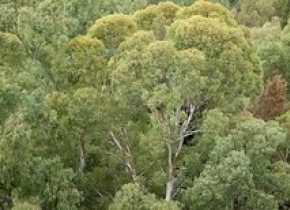
一些树木通过流汗来对抗炎热
在极端热浪期间,一种桉树能通过释放水分和利用蒸腾作用降温来应对炎热。其他树木可能也能这么做。
撰文\播音:史蒂夫·米尔斯基(Steve Mirsky)
翻译:陈美娟
审校:杨枭
Hi, I’m Scientific American podcast editor Steve Mirsky. Here’s a short piece from the May 2018 issue of the magazine, in the section we call Advances: Dispatches from the Frontiers of Science, Technology and Medicine:
大家好,我是《科学美国人》的博客编辑史蒂夫·米尔斯基(Steve Mirsky)。以下是一篇选自《发展:科学,技术与医药前瞻研究》杂志的短篇文章:
Sweaty Trees, by Yasemin Saplakoglu
《会发汗的树》——雅斯敏·萨普拉科鲁(Yasemin Saplakoglu)作。
Recent summer temperatures in parts of Australia were high enough to melt asphalt. As global warming cranks up the heat and climatic events intensify, many plants may be unable to cope. But at least one species of eucalyptus tree can withstand extreme heat by continuing to “sweat” when other essential processes taper off.
最近,澳大利亚的夏季温度高到能使沥青熔化。由于全球变暖增加了热量和气候变化的总量,许多植物可能无法应对这样的变化了。不过,至少有一种桉树能在其他方法行不通的情况下,通过持续性的“流汗”来应对极端高温天气。
As plants convert sunlight into food, or photosynthesize, they absorb carbon dioxide through pores on their leaves. These pores also release water via transpiration, which circulates nutrients through the plant and helps cool it by evaporation. But exceptionally high temperatures are known to greatly reduce photosynthesis—and most existing plant models suggest this should also decrease transpiration, leaving trees in danger of fatally overheating. Because it is difficult for scientists to control and vary trees' conditions in their natural environment, little is known about how individual species handle this situation.
当植物将阳光转化为养分——也就是光合作用的过程中,它们通过叶片上的气孔吸收二氧化碳。这些气孔还能通过蒸腾作用,让养分在体内循环,通过蒸发来降温,得以释放水分。但是高温无一例外能大大降低光合作用效率,多数现有的植物生命模型同样显示这能使蒸腾作用减弱,让树木暴露在致命的高温中。由于科学家难以掌控和改变树木的自然成长环境,我们对单一树种如何应对这种情况几乎一无所知。
Ecologist John Drake of the S.U.N.Y. College of Environmental Science and Forestry and his colleagues grew a dozen Parramatta red gum (Eucalyptus parramattensis) in large, climate-controlled plastic pods that isolated the trees from the surrounding forest for a year in Richmond, Australia. Six of the trees were grown at ambient air temperatures and six at temperatures three degrees Celsius higher. The researchers withheld water from the surface soil of all 12 trees for a month to simulate a mild dry spell, then induced a four-day “extreme” heat wave: They raised the maximum temperatures in half of the pods (three with ambient temperatures and three of the warmer ones)—to 44 degrees C.
生态学家约翰·德雷克(John Drake)来自苏尼环境科学与林业学院,,他和他的同事们在澳大利亚里士满巨大的塑料棚里种了12棵帕拉玛塔红桉树,将这些桉树与周围的森林隔离了一年的时间。六棵树的生存温度与周围环境相同,六棵树的生存温度比周围环境温度高六摄氏度。研究者们在一个月内限制12棵树土壤表面水分无流入,以此获得一个干燥的土壤环境,然后制造一个持续四天的“极端”热浪环境:他们在半数的塑料腔中提升最高温度(三个是室温环境,三个是高温些的环境)到44摄氏度。
Photosynthesis ground to a near halt in the trees facing the artificial heat wave. But to the researchers' surprise, these trees continued to transpire at close-to-normal levels, effectively cooling themselves and their surroundings. The trees grown in warmer conditions coped just as well as the others, and photosynthesis rates bounced back to normal after the heat wave passed, Drake and his colleagues reported these findings in Global Change Biology.
当树木面临人造的热浪时光合作用几乎完全停止。但让研究者意外的是,这些树木还能以几乎正常的状态进行蒸腾作用,这可以有效地为它们自己和周围环境降温。这些种在更温暖环境下的树木能和其它树木一样应对环境变化,当给予的热浪消失之后光合速率立刻返回到正常水平。德雷克和他的同事们将这些发现发表在了《生物全球变化》上。
The researchers think the Parramatta red gums were able to effectively sweat—even without photosynthesis—because they are particularly good at tapping into water deep in the soil. But if a heat wave and a severe drought were to hit at the same time and the groundwater was depleted, the trees may not be so lucky.
研究者认为,即使在没有光合作用的情况下,帕拉玛塔红桉树也能够有效地发汗——因为它们精于从土壤中深深地汲取水分。但要是热浪和严峻干旱同时来袭的话,地下水耗尽之后这些树可能就没那么幸运了。
Drake hopes to conduct similar experiments with trees common in North America.
德雷克希望能在北美用同样的树进行相同的实验
未经书面许可任何人不得复制或镜像
京ICP备11000850号-1
 京公网安备11010502039775号
京公网安备11010502039775号 信息网络传播视听节目许可证0111611号
国家科技基础条件平台

















